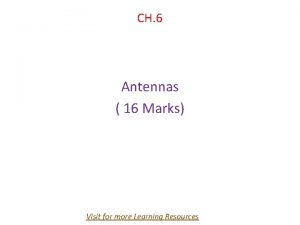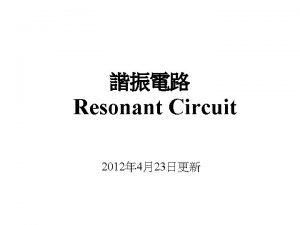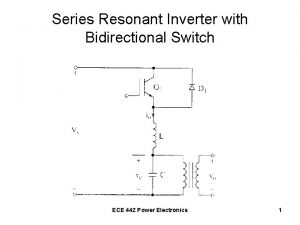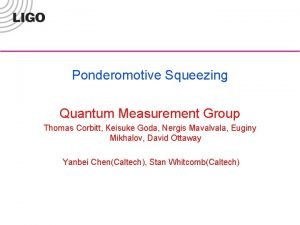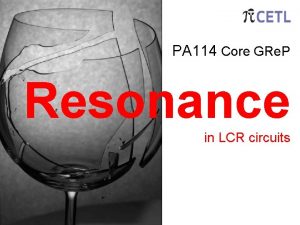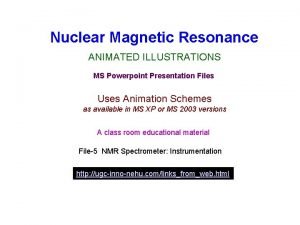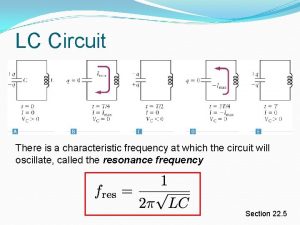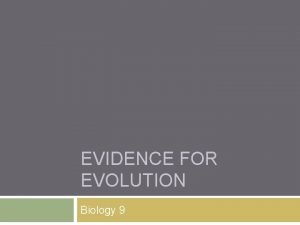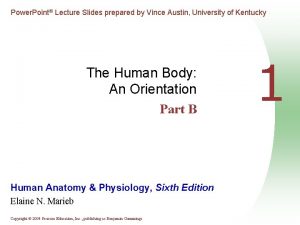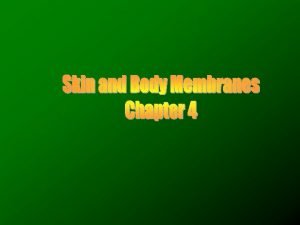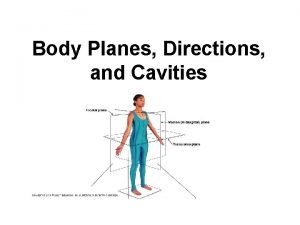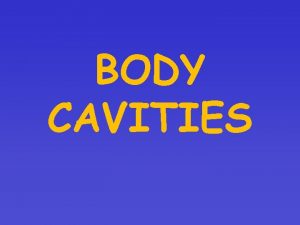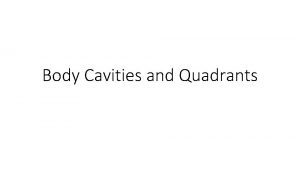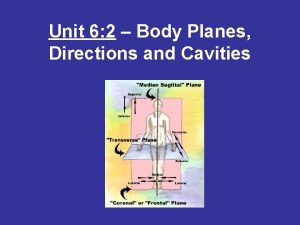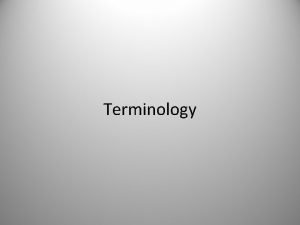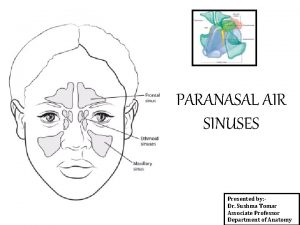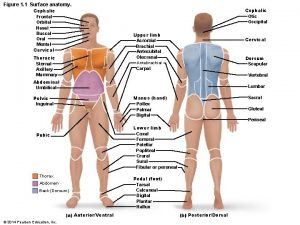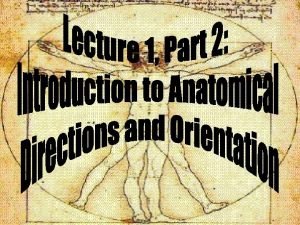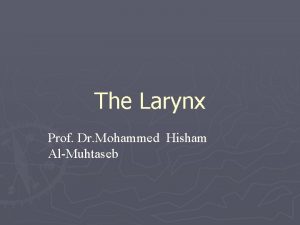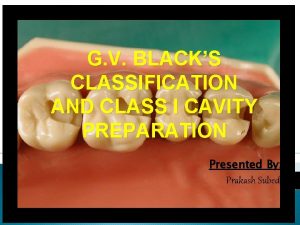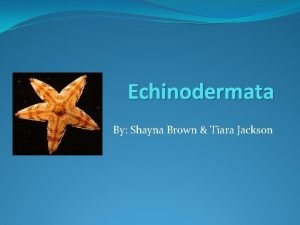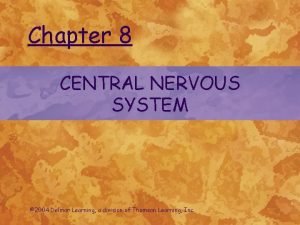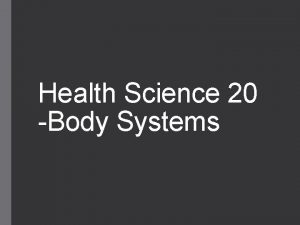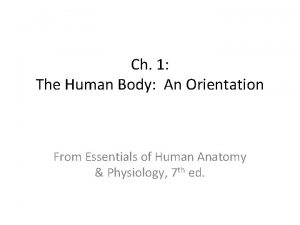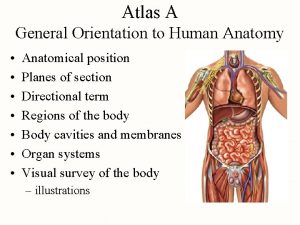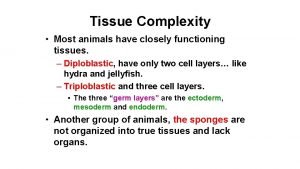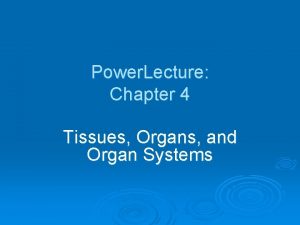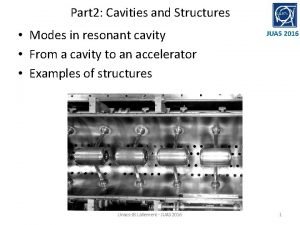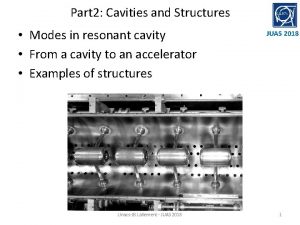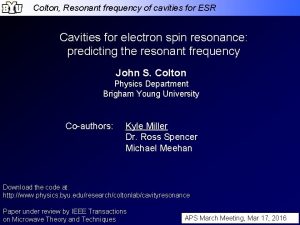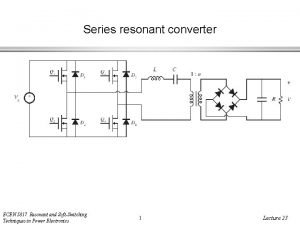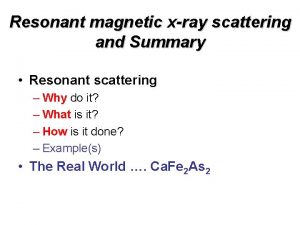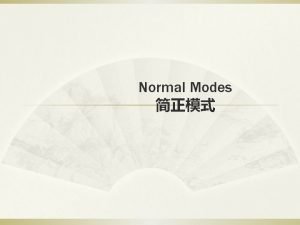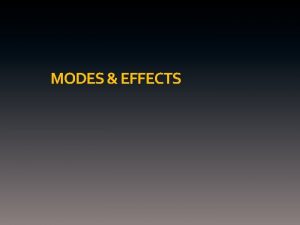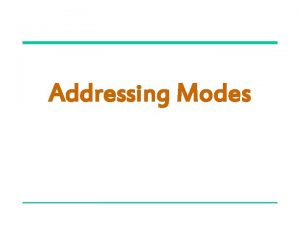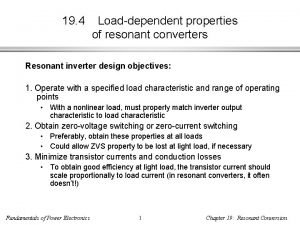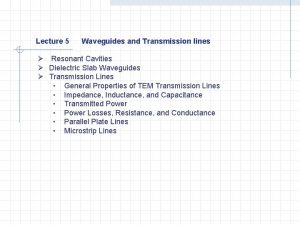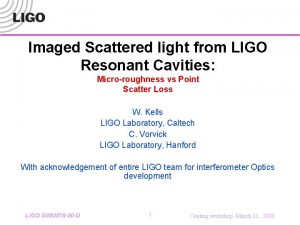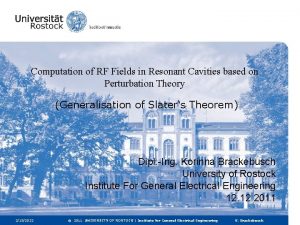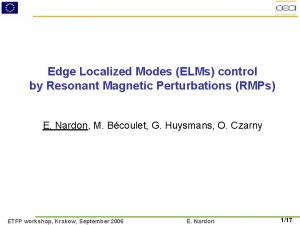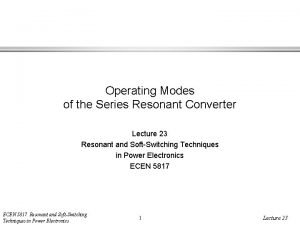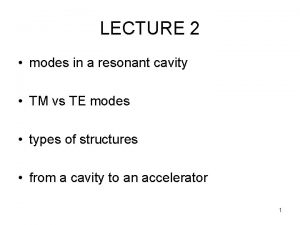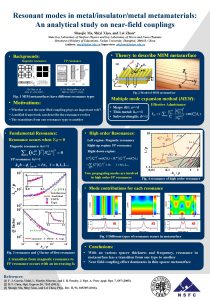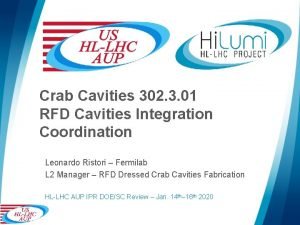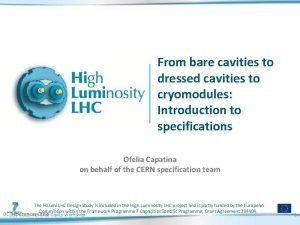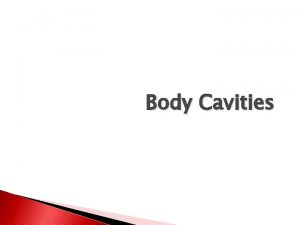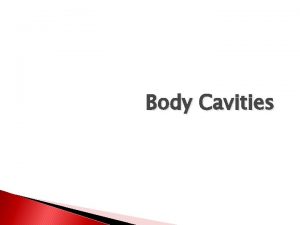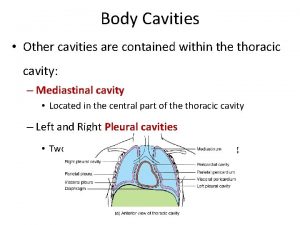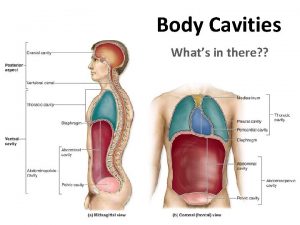Part 2 Cavities and Structures Modes in resonant
































- Slides: 32

Part 2: Cavities and Structures • Modes in resonant cavity • From a cavity to an accelerator • Examples of structures Linacs-JB. Lallement - JUAS 2015 1

Cavity modes Wave equation Maxwell equation for electromagnetics waves • In free space the electromagnetic fieds are of the transverse electromagnetic, TEM type: Electric and magnetic field vectors are to each oher and to the direction of propagation ! • In a bounded medium (cavity) the solution of the equation must satisfy the boundary conditions: Linacs-JB. Lallement - JUAS 2015 2

Cavity modes TE and TM modes • TE mode (transverse electric): The electric field is perpendicular to the direction of propagation in a cylindrical cavity. m: azimuthal n: radial • TM mode (transverse magnetic): The magnetic field is perpendicular to the direction of propagation in a cylindrical cavity. m: azimuthal n: radial Linacs-JB. Lallement - JUAS 2015 3

Cavity modes TE modes • The two Transverse Electric modes for accelerating structures are: Linacs-JB. Lallement - JUAS 2015 4

Cavity modes TM modes • The most commonly used Transverse Magnetic mode for accelerating structures is: Linacs-JB. Lallement - JUAS 2015 5

Cavity modes TM modes • The most commonly used for accelerating structures are the TM modes: TM 010 : f=352. 2 MHz TM 011 : f=548 MHz Linacs-JB. Lallement - JUAS 2015 TM 020 : f=952 MHz 6

Cavity modes From a cavity to an accelerator Standing Wave Modes Mode 0 also called mode 2π. For synchronicity and acceleration, particles must be in phase with the E field on axis (will be discussed more in details in part. 3). During 1 RF period, the particles travel over a distance of βλ. The cell L lentgh should be: Named from the phase difference between adjacent cells. Mode L 2π βλ π/2 βλ/4 2π/3 βλ/3 π βλ/2 Linacs-JB. Lallement - JUAS 2015 7

Basic structures Basic accelerating structures • TE mode: • Radio Frequency Quadrupole: RFQ • Interdigital-H structure: IH • TM mode: • Drift Tube Linac: DTL • Cavity Coupled DTL: CCDTL • PI Mode Structure: PIMS • Superconducting cavities Linacs-JB. Lallement - JUAS 2015 8

Basic structures RFQ Radio Frequency Quadrupole Linacs-JB. Lallement - JUAS 2015 9

Basic structures RFQ Radio Frequency Quadrupole Linacs-JB. Lallement - JUAS 2015 10

Basic structures RFQ Radio Frequency Quadrupole Linacs-JB. Lallement - JUAS 2015 11

Basic structures RFQ 4 vane-structure 1. Capacitance between vanes, inductance in the intervane volume. 2. Each quadrant is a resonator 3. Frequency depends on cylinder dimensions. 4. Vane tip are machined by a computer controlled milling machine. 5. Need stabilization (problem of mixing with dipole- JUAS mode Linacs-JB. Lallement 2015 TE 11). 12

Basic structures RFQ 4 rod-structure 1. Capacitance between rods, inductance with holding bars. 2. Each cell is a resonator 3. Cavity dimensions are independent from the frequency. 4. Easy to machine. 5. Problem with end cells. Less efficient than 4 vane -due to strong current in holding bars. Linacs-JB. Lallement JUAS 2015 13

Basic structures RFQ Radio Frequency Quadrupole ++- Linacs-JB. Lallement - JUAS 2015 14

Basic structures RFQ Acceleration in RFQ longitudinal modulation on the electrodes creates a longitudinal component in the TE mode Linacs-JB. Lallement - JUAS 2015 15

Basic structures RFQ Acceleration in RFQ + - + + Linacs-JB. Lallement - JUAS 2015 16

Basic structures RFQ parameters Focusing term Acceleration term a=bore radius m=modulation m 0=rest mass β=reduced velocity λ=wave length f=frequency k=wave number V=vane voltage I 0, 1= zero and first order Bessel function Linacs-JB. Lallement - JUAS 2015 17

Basic structures RFQ • • • RFQ The resonating mode of the cavity is a focusing mode Alternating the voltage on the electrodes produces an alternating focusing channel A longitudinal modulation of the electrodes produces a field in the direction of propagation of the beam which bunches and accelerates the beam Both the focusing as well as the bunching and acceleration are performed by the RF field The RFQ is the only linear accelerator that can accept a low energy CONTINOUS beam of particles 1970 Kapchinskij and Teplyakov propose the idea of the radiofrequency quadrupole ( I. M. Kapchinskii and V. A. Teplvakov, Prib. Tekh. Eksp. No. 2, 19 (1970)) Acceleration Bunching Transverse focusing Linacs-JB. Lallement - JUAS 2015 18

Basic structures IH Interdigital H structure Linacs-JB. Lallement - JUAS 2015 19

Basic structures IH Interdigital H structure • Stem on alternating side of the drift tube force a longitudinal field between the drift tubes • Focalisation is provided by quadrupole triplets places OUTSIDE the drift tubes or OUTSIDE the tank Linacs-JB. Lallement - JUAS 2015 20

Basic structures IH Interdigital H structure • very good shunt impedance in the low beta region (( 0. 02 to 0. 08 ) and low frequency (up to 200 MHz) • not for high intensity beam due to long focusing period • ideal for low beta heavy ion acceleration Linacs-JB. Lallement - JUAS 2015 21

Basic structures DTL Drift Tube Linacs-JB. Lallement - JUAS 2015 22

Basic structures DTL Drift Tube Linac Tutorial ! Linacs-JB. Lallement - JUAS 2015 23

Basic structures DTL Disc loaded structure Operation in 2π mode Drift Tube Linac Add tubes for high shunt impedance Remove the walls to increase coupling between cells Particles are inside the tubes when the electric field is decelerating. Quadrupole can fit inside the drift tubes. β=0. 04 -0. 5 (750 ke. V – 150 Me. V) Synchronism condition for 2π mode : Cell length should increase to account for the beta increase Ideal for low β – low W - high current Linacs-JB. Lallement - JUAS 2015 24

Basic structures DTL Drift Tube Linac CERN Linac 2 DTL CERN Linac 4 DTL Linacs-JB. Lallement - JUAS 2015 25

Basic structures CCDTL Coupled Cavity DTL Linacs-JB. Lallement - JUAS 2015 26

Basic structures CCDTL Coupled Cavity DTL Linacs-JB. Lallement - JUAS 2015 27

Basic structures SCL Side Coupled Cavity multi-cell Standing Wave structure in p/2 mode frequency 800 - 3000 MHz for protons (b=0. 5 - 1) Rationale: high beta cells are longer advantage for high frequencies • at high f, high power (> 1 MW) klystrons available long chains (many cells) • long chains high sensitivity to perturbations operation in p/2 mode Side Coupled Structure: - from the wave point of view, p/2 mode - from the beam point of view, p mode Linacs-JB. Lallement - JUAS 2015 28

Basic structures PIMS Pi Mode Structure beam Linacs-JB. Lallement - JUAS 2015 29

Basic structures SC cavities Superconducting cavities Some examples Multi gap cavities (elliptical) Operate in π mode β>0. 5 -0. 7 350 -700 MHz (protons) 0. 35 -3 GHz (electrons) Other SC cavities (spoke, HWR, QWR) β>0. 1 From 1 to 4 gaps. Can be individually phased. Space for transverse focusing in between Ideal for low β - CW proton linacs. Linacs-JB. Lallement - JUAS 2015 30

Basic structures • • • The choice of the structures Particle type : mass and charge Beam current Duty factor (pulsed, CW) Frequency Energy Operational constraints Cavity Type Beta Range Frequency Particles RFQ Low! – 0. 1 40 -500 MHz Protons, Ions IH 0. 02 – 0. 08 40 -100 MHz Ions (Protons) DTL 0. 05 – 0. 5 100 -400 MHz Protons, Ions SCL 0. 5 – 1 (ideal is 1) 600 -3000 MHz Protons, Electrons HWR-QWR-Spokes 0. 02 -0. 5 100 -400 MHz Protons, Ions Elliptical 350 – 3000 MHz Protons, Electrons > 0. 5 -0. 7 Not exhaustive. Linacs-JB. Lallement list – To take- JUAS with caution !!! 2015 31

Basic structures • • • The choice of the structures Particle type : mass and charge Beam current Duty factor (pulsed, CW) Frequency Energy Operational constraints Cavity Type Beta Range Frequency Particles RFQ Low! – 0. 1 40 -500 MHz IH To 40 -100 MHz with 100 -400 MHz 0. 05 Take – 0. 5 CAUTION – 1 (ideal is 1) !!! 600 -3000 MHz Protons, Ions 0. 02 – 0. 08 > 0. 5 -0. 7 DTL SCL Ions (Protons) Protons, Ions Protons, Electrons HWR-QWR-Spokes 0. 02 -0. 5 100 -400 MHz Protons, Ions Elliptical 350 – 3000 MHz Protons, Electrons Not exhaustive. Linacs-JB. Lallement list – To take- JUAS with caution !!! 2015 32
 Current and voltage distribution in antenna
Current and voltage distribution in antenna Rlc-423
Rlc-423 Ece 442
Ece 442 Resonant frequency
Resonant frequency Resonant frequency
Resonant frequency Resonant frequency formula
Resonant frequency formula Resonant inductive coupling ppt
Resonant inductive coupling ppt Resonant frequency formula
Resonant frequency formula Function of homologous structure
Function of homologous structure The anterior and posterior body cavities
The anterior and posterior body cavities Dorsal and ventral body cavities
Dorsal and ventral body cavities Chapter 7.2 body planes directions and cavities
Chapter 7.2 body planes directions and cavities What are the three main types of body membranes
What are the three main types of body membranes Body planes directions and cavities
Body planes directions and cavities Body cavity label
Body cavity label Vertebral cavity
Vertebral cavity The midsagittal plane divides the body into
The midsagittal plane divides the body into Dressed to the
Dressed to the Jhuma biswas homeopathy
Jhuma biswas homeopathy Middle meatus drainage
Middle meatus drainage Five body cavities
Five body cavities Body cavities labeled
Body cavities labeled Palms facing posterior
Palms facing posterior Laryngeal cavities
Laryngeal cavities Blacks classification
Blacks classification Echinoderm body cavity
Echinoderm body cavity The brain contains four lined cavities called
The brain contains four lined cavities called Body cavities
Body cavities Body orientation definition
Body orientation definition Major body cavities
Major body cavities Animal body cavities
Animal body cavities Dorsal cavity
Dorsal cavity Body cavities
Body cavities
